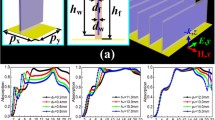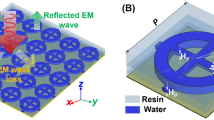Abstract
This paper present transparent, all dielectric water-based metamaterial (MM) superstrates with reconfigurable characteristics is employed for gain and bandwidth enhancement of a water-based microstrip patch antenna. The water-based microstrip patch antenna is fed by an L-shape probe. All dielectric water-based MM unit-cell element consists of dielectric cubic boxes filled with water is designed and analyzed. The reconfigurable electric properties are achieved via changing the water height in the MM unit-cell element. Different arrangements of the MM array with water height tapering are optimized and designed for microstrip patch antenna gain enhancement. The MM array is used as a single layer superstrate placed normal to the microstrip patch. A water-based MM lens consists of three layers is designed to collimate the radiation from the microstrip patch antenna. The phase compensation in the MM lens is achieved via changing the water height in the MM unit-cell elements of the lens. A reconfigurable beam in different directions from −30° to +30° is steered by changing the water level distribution over the MM lens unit-cell elements. A full-wave analysis using the finite integration technique is used for the design and analysis of the water-based MM lens arrangements.
















Similar content being viewed by others
References
Skobelev, S. P. (2011). Phased array antennas with optimized element patterns. Boston: Artech House.
Garg, R. (2001). Microstrip antenna design handbook. Boston: Artech House.
Cadoret, D., Laisné, A., Gillard, R., & Legay, H. (2005). A new reflectarray cell using microstrip patches loaded with slots. Microwave and Optical Technology Letters,44(3), 270–272.
O’Keefe, S. G., & Kingsley, S. P. (2007). Tunability of liquid dielectric resonator antennas. IEEE Antennas and Wireless Propagation Letters,6, 533–536.
Fayad, H., & Record, P. (2006). Broadband liquid antenna. Electronics Letters,42(3), 133–134.
Qian, Y., & Chu, Q. X. (2017). A compact broadband water patch antenna. IEEE Antennas and Wireless Propagation Letters,16, 1911–1914.
Singh, P., Aggarwal, A., & Choukiker, Y. K. (2017). Transparent water dense dielectric patch antenna. ARPN Journal of Engineering and Applied Sciences,12(17), 5212–5220.
Li, Y., & Luk, K. M. (2015). A water dense dielectric patch antenna. IEEE Access,3, 274–280.
Zhou, R., Zhang, H., & Xin, H. (2009). A compact water based dielectric resonator antenna. Charleston: International Symposium on Antennas and Propagation Society.
Sun, J., & Luk, K. M. (2016). A wideband transparent water patch antenna. In Conference on antenna measurements and applications (CAMA), Syracuse, NY, USA.
Fayad, H., & Record, P. (2005). Wideband saline-water antenna (pp. 197–201). Birmingham: Wideband and Multi-band Antennas and Arrays conference.
Xing, L., Huang, Y., Xu, Q., & Alja’afreh, S. (2015). A wideband hybrid water antenna with an F-shaped monopole. IEEE Access,3, 1179–1187.
Hu, Z., Wu, W., Shen, Z., & Hua, C. (2015). A Yagi monopole antenna made of pure water. Vancouver: IEEE International Symposium on Antennas and Propagation.
Zouhdi, S., Ari, S., & Alexey, P. (2008). Metamaterials and plasmonics: Fundamentals, modelling, applications. Berlin: Springer.
Gangwar, K., & Gangwar, R. P. S. (2014). Metamaterials: Characteristics, process and applications. Advance in Electronic and Electric Engineering,4(1), 97–106.
Zainud-Deen, S. H., Mabrouk, A. M., & Malhat, H. A. (2018). Frequency tunable graphene metamaterial reflectarray. Wireless Personal Communications. https://doi.org/10.1007/s11277-018-5884-1.
Zainud-Deen, S. H., Mabrouk, A. M., & Malhat, H. A. (2018). Terahertz graphene based metamaterial transmitarray. Wireless Personal Communications,100(3), 1235–1248.
Moitra, P., Yang, Y., Anderson, Z., Kravchenko, I., Briggs, D., & Valentine, J. (2013). Realization of an all-dielectric zero-index optical metamaterial. Applied Physics Letters (AIP),7, 791–795.
Jahani, S., & Jacob, Z. (2016). All-dielectric metamaterials. Nature Nanotechnology,11, 23–36.
Kamada, S., Michishita, N., & Yamada, Y. (2010). Metamaterial lens antenna using dielectric resonators for wide angle beam scanning. Toronto: International Symposium of Antennas and Propagation Society.
Sun, L., Feng, S., & Yang, X. (2012). Loss enhanced transmission and collimation in anisotropic epsilon-near-zero metamaterials. Applied Physics Letters,101(24), 241101.
Ibrahim, M., Zainud-Deen, S. H., & Botros, A. Z. (2012). radiation and scattering from bodies coated with metamaterials by GPU, LAP LAMBRET Academic Publishing. Deutschland: AV Akademikerverlag GmbH & Co. KG.
Clemens, M., & Weiland, T. (2001). Discrete electromagnetism with the finite integration technique. Progress In Electromagnetics Research,32, 65–87.
Zhou, X., & Pan, G. W. (2006). Application of physical spline finite element method (PSFEM) to full wave analysis of waveguide. Progress In Electromagnetics Research,60, 19–41.
Feng, B. (2006). Extracting material constitutive parameters from scattering parameters, M.Sc. Thesis, Naval Postgraduate School, Monterey, California.
Makanjuola, N. T., Shoewu, O. O., Akinyemi, L. A., & Ajasa, A. A. (2015). Design and development of microcontroller based liquid level detector with graphical output. Pacific Journal of Science and Technology, 16, 173–181.
Author information
Authors and Affiliations
Corresponding author
Additional information
Publisher's Note
Springer Nature remains neutral with regard to jurisdictional claims in published maps and institutional affiliations.
Rights and permissions
About this article
Cite this article
Zainud-Deen, S.H., Badawy, M.M. & Malhat, H.A. Reconfigurable Transparent All-Dielectric Water-Based Metamaterial for Microstrip Patch Antenna Gain Enhancement. Wireless Pers Commun 111, 443–461 (2020). https://doi.org/10.1007/s11277-019-06868-z
Published:
Issue Date:
DOI: https://doi.org/10.1007/s11277-019-06868-z




